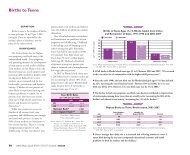2010 Rhode Island Kids Count Factbook
2010 Rhode Island Kids Count Factbook
2010 Rhode Island Kids Count Factbook
You also want an ePaper? Increase the reach of your titles
YUMPU automatically turns print PDFs into web optimized ePapers that Google loves.
Homeless and Runaway Youth<br />
DEFINITION<br />
Homeless and runaway youth is the<br />
number of youth in <strong>Rhode</strong> <strong>Island</strong> who<br />
accessed emergency shelter services<br />
without their families or who were<br />
absent without leave (AWOL) from<br />
state care placements (including youth<br />
in child welfare and juvenile justice<br />
community placements).<br />
SIGNIFICANCE<br />
There are three primary causes of<br />
homelessness among youth – family<br />
conflict, residential instability resulting<br />
from foster care and institutional<br />
placements, and economic problems.<br />
Many homeless youth run away due to<br />
physical and sexual abuse, strained<br />
family relationships, substance abuse by<br />
a family member and/or parental<br />
neglect. 1,2<br />
Other youth become homeless when<br />
they run away from or are discharged<br />
from the foster care or juvenile justice<br />
systems. In U.S. shelters, more than one<br />
in five homeless youth comes directly<br />
from foster care and more than one in<br />
four were in foster care in the previous<br />
year. Homeless youth with histories of<br />
foster care placements often become<br />
homeless at an earlier age and remain<br />
homeless for longer periods than their<br />
peers. 3,4<br />
Youth who identify as gay, lesbian,<br />
bisexual, transgender or queer<br />
(LGBTQ) are overrepresented in the<br />
homeless youth population, some of<br />
whom report being forced out of their<br />
homes by parents who disapprove of<br />
their sexual orientation or gender<br />
identity. LGBTQ homeless youth also<br />
experience greater levels of physical and<br />
sexual exploitation while living on the<br />
streets than their heterosexual peers. 5,6<br />
It is often difficult for homeless<br />
youth to obtain the food, clothing and<br />
medical care they need. While living on<br />
the streets, homeless youth are at risk of<br />
sexual exploitation and many turn to<br />
selling drugs, shoplifting, theft or<br />
prostitution to provide for their basic<br />
needs. Consequently, homeless youth<br />
face an increased risk of arrests and are<br />
more likely to contract sexually<br />
transmitted infections. 7,8<br />
Homeless youth are typically<br />
disconnected from community resources<br />
such as education, employment, and<br />
health care. 9 They often have difficulty<br />
enrolling in school without a parent or<br />
guardian, and they are more likely than<br />
their peers to have been suspended,<br />
expelled, repeated grades and to have<br />
dropped out of school. 10,11<br />
Homeless youth experience higher References<br />
1,4,7,11,22<br />
rates of depression, post-traumatic stress<br />
National Coalition for the Homeless. (2008).<br />
disorder, substance abuse and other<br />
mental health problems than youth with<br />
stable housing. Health issues can go<br />
untreated due to lack of access to health<br />
and mental health care. In addition,<br />
homeless youth may not seek needed<br />
health care because they are likely to be<br />
asked for a permanent address, health<br />
insurance information or parental<br />
permission for treatment. 12,13<br />
Homeless youth. (NCH fact sheet #13). Retrieved<br />
February 16, 2009 from<br />
http://www.nationalhomelesss.org<br />
2,5<br />
Julianelle, P. (2008). Using what we know: Supporting<br />
the education of unaccompanied homeless youth.<br />
Washington, DC: The National Association for the<br />
Education of Homeless Children and Youth.<br />
3,9,12<br />
U.S Department of Health and Human Services.<br />
(2007). Promising strategies to end youth homelessness:<br />
Report to Congress. Washington, DC: U.S.<br />
Department of Health and Human Services,<br />
Administration for Children and Families.<br />
Homeless Youth in <strong>Rhode</strong> <strong>Island</strong><br />
◆ There is one emergency shelter in <strong>Rhode</strong> <strong>Island</strong> tailored to the needs of<br />
unaccompanied and runaway homeless youth in <strong>Rhode</strong> <strong>Island</strong>. During Federal Fiscal<br />
Year (FFY) 2009, 14 unaccompanied youth ages 12 to 18 received Basic Center services<br />
(up to 21 days of emergency shelter) and five youth ages 17 and 18 received Transitional<br />
Living services (long-term residential and supportive services) in <strong>Rhode</strong> <strong>Island</strong> programs<br />
funded through the federal Runaway and Homeless Youth Program. 14,15,16,17<br />
◆ Sixty single youth ages 18 to 20 and 130 young adults ages 21 to 24 received emergency<br />
shelter services though the adult emergency shelter system in <strong>Rhode</strong> <strong>Island</strong> in 2009. 18<br />
◆ In 2009, the National Runaway Switchboard handled 193 crisis-related calls regarding<br />
youth ages 21 and under who were homeless, runaways, or at risk of homelessness in<br />
<strong>Rhode</strong> <strong>Island</strong>. Nationally, 50% of callers to the Switchboard in 2009 were youth and the<br />
rest were friends, family, and other adults. 19<br />
◆ On December 31, 2009, there were 69 youth in the care of the <strong>Rhode</strong> <strong>Island</strong><br />
Department of Children, Youth and Families who were classified as unauthorized<br />
absences/runaways (AWOL), 31 of whom were female and 38 of whom were male.<br />
These youth were be AWOL from either foster care or juvenile justice placements. 20<br />
◆ There were an additional 248 youth ages 13 to 17 who received emergency shelter<br />
services with their families in <strong>Rhode</strong> <strong>Island</strong> in 2009. 21 These youth are vulnerable to<br />
being separated from their families due to shelter or child welfare policies. 22<br />
6<br />
Incidence and vulnerability of LGBTQ homeless youth.<br />
(n.d.). Youth Homelessness Series: Brief No. 2.<br />
Washington, DC: National Alliance to End<br />
Homelessness.<br />
8,13<br />
Aratani, Y. (2009). Homeless children and youth: Causes<br />
and consequences. New York, NY: National Center for<br />
Children in Poverty, Mailman School of Public<br />
Health, Columbia University.<br />
(continued on page 167)<br />
<strong>2010</strong> <strong>Rhode</strong> <strong>Island</strong> KIDS COUNT <strong>Factbook</strong> 91






